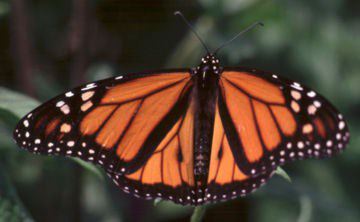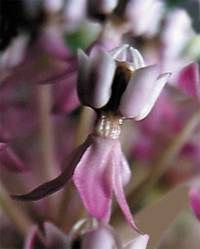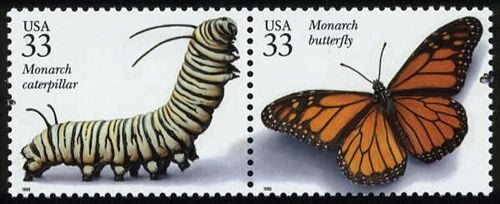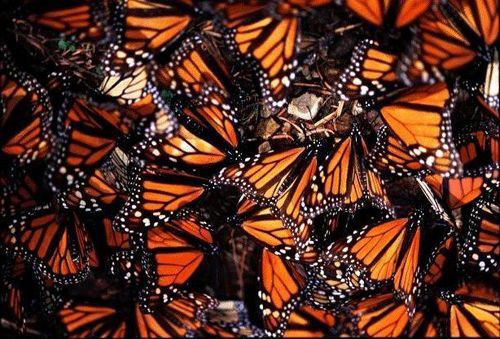|
Densely clustered Monarch butterfly populations on the wintering grounds in Mexico (above) have been devastated in recent years by storms and on-going habitat destruction. There is speculation, albeit controversial, that Monarchs soon may not be able to rebound from annual losses of tens of millions of individuals.
You may not have much say about logging or the weather in Mexico, but you DO have control over what happens in your own backyard. Perhaps the best thing you can do to help Monarchs locally is to provide plantings for them. Here are some hints to remember:
- There are two kinds of "butterfly plants": Nectar Plants that produce flowers that adult butterflies use for nourishment and Host Plants upon which adult butterflies lay eggs and/or from which caterpillars eat the foliage. For some butterfly species, nectar and host plants are the same.
 Ephemeral adults in some butterfly species don't eat at all, but long-lived Monarch adults (male at right) dine on many different nectar plants. Ephemeral adults in some butterfly species don't eat at all, but long-lived Monarch adults (male at right) dine on many different nectar plants.
- Monarch butterflies, Danaus plexippus, only lay their eggs on Milkweed plants (Asclepias spp. and, occasionally, various genera of Viny Milkweeds.) Two of their favorites are Common Milkweed, A. syriaca, and Butterfly-weed, A. tuberosa.
- Lots of people plant showy nectar flowers such as Butterfly Bush, Buddleja davidii, but not many put in the all-important Monarch host plants required for caterpillar growth and development.
- Milkweed seeds (and starter plants) are available from commercial nurseries and Web sites, or you can collect your own in fall when Milkweeds form large green pods.
- Milkweeds can be grown from seeds, but only after they have been vernalized (by cooling) and scarified (by lightly scratching the seed case so that water can be absorbed).
 Milkweed plants require a sunny spot, and most species do best in non-clay soils. Swamp Milkweed, A. incarnata (close-up of individual flower at right), will do well in wet locations. Milkweed plants require a sunny spot, and most species do best in non-clay soils. Swamp Milkweed, A. incarnata (close-up of individual flower at right), will do well in wet locations.
- There are plenty of native Milkweed species that are becoming less common as local habitat is lost. Select them instead of exotic species and help save Monarchs AND Milkweeds.
- Insecticides are almost always non-selective. Remember that every time you use a chemical to kill unwanted insects, you also may be killing Monarch caterpillars or adults (below). In other words, try to eliminate insect pests through biological controls such as Ladybugs, Preying Mantids, and Marigolds instead of chemical treatments.
- And be careful with herbicides. Pull those weeds rather than spraying them, lest the chemicals drift and kill the milkweed, too.

All text & photos © Hilton Pond Center
Also see the article on "Welcome Them With Milkweed"
by Nancy Brachey, Garden Editor of The Charlotte Observer
|



 Ephemeral adults in some butterfly species don't eat at all, but long-lived Monarch adults (male at right) dine on many different nectar plants.
Ephemeral adults in some butterfly species don't eat at all, but long-lived Monarch adults (male at right) dine on many different nectar plants.
 Milkweed plants require a sunny spot, and most species do best in non-clay soils. Swamp Milkweed, A. incarnata (close-up of individual flower at right), will do well in wet locations.
Milkweed plants require a sunny spot, and most species do best in non-clay soils. Swamp Milkweed, A. incarnata (close-up of individual flower at right), will do well in wet locations.



